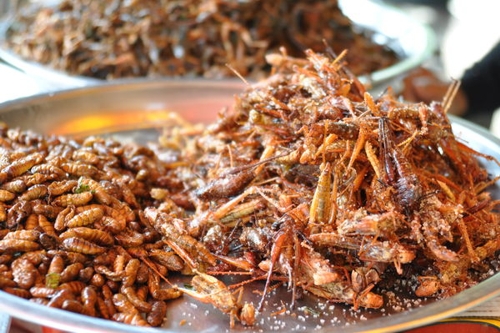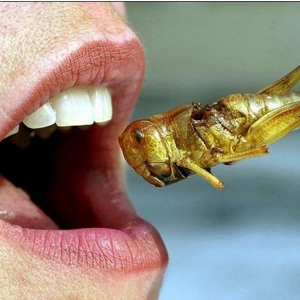‘Alternative proteins’ are coming. Are you ready? Two researchers at the University of Guelph Food Institute published an open letter in the Ottawa Citizen this morning, predicting that way-out protein sources such as Algae and Insects could become mainstream in as little as ten years…
 Feast of the future? Fried Bamboo Worm Larvae (left), and Crispy Crickets (right)
Feast of the future? Fried Bamboo Worm Larvae (left), and Crispy Crickets (right)
might star on an Insect Buffet some day. But not soon…
Geographer Evan Frazer and Professor of Food Distribution and Policy Sylvain Charlebois point out that climate and economic trends are poised to trigger a major shift in global agriculture:
Farmed fish, legumes and pulses, insects, fungi and algae all have the potential to make major inroads into global diets. Cold-blooded salmon require much less energy than warm-blooded mammals to raise and hence are far more efficient at converting feed into muscle. Pigs produce between 10 and 100 times more greenhouse gas emissions per kilogram than meal worms, and one kg of meat from ruminant animals produces 500 to 1,500-per-cent more greenhouse gas emissions than a kilogram of lentils.
In support of their theory, they point out that Algae Powder is already being used in some athletic drinks and Cricket Flour is being incorporated in some Energy Bars. Lentils are a staple in Asia and are already a hit in the diets of Western sustainable food activists and supporters of Vegetarian and Vegan diets.
How will alternative proteins worm their way into our Western diet?
There are two potential paths on which alternative proteins might enter the human food chain soon: As livestock feed and in processed food products – like the aforementioned Energy Bars and Athletic Drinks.
But getting widespread public acceptance of alternative proteins directly in the Western Diet will require a more concerted marketing approach, Fraser and Charlebois point out. They don’t hazard a prediction on how soon BBQ Crickets and Lentil Chili may replace the traditional go-to choices for game day fare:
For that, we have the sushi industry’s playbook. In the early 1980s, most Western consumers considered the idea of eating raw fish disgusting. History, however, shows how quickly tastes can change. Within 10 years, sushi had morphed from alien and revolting to a popular part of the food landscape.
Given that the Sushi craze started in the 1980s, might we not seriously question the professors’ ten-year prediction?
In rebuttal…
Allow me to point out that Sushi still appeals to a much smaller segment of the dining public in the West than it does in the East, where the Japanese literally eat it up. And its popularity in the West appears to have plateaued. Though lentils are the hero of vegetarian and vegan diners here in the West, they are not really making big inroads into the dietary mainstream. I believe it will take at least two generations (allowing 20 years for each new generation to mature to the stage where it sets its own preferences and makes its own choices) before Insects, Algae and the like go mainstream.
~ Maggie J.

